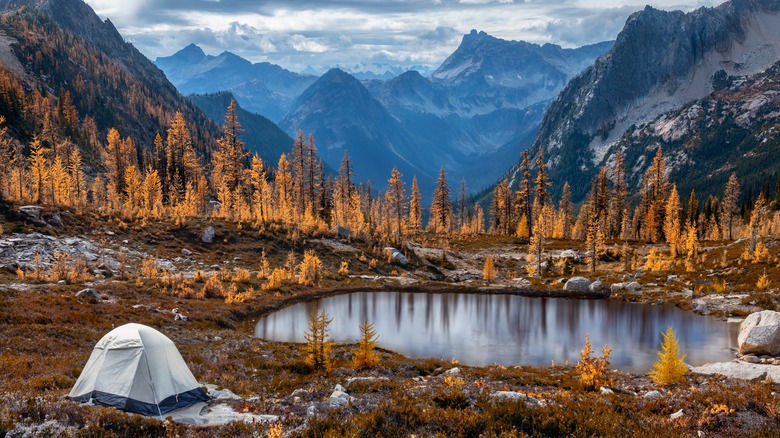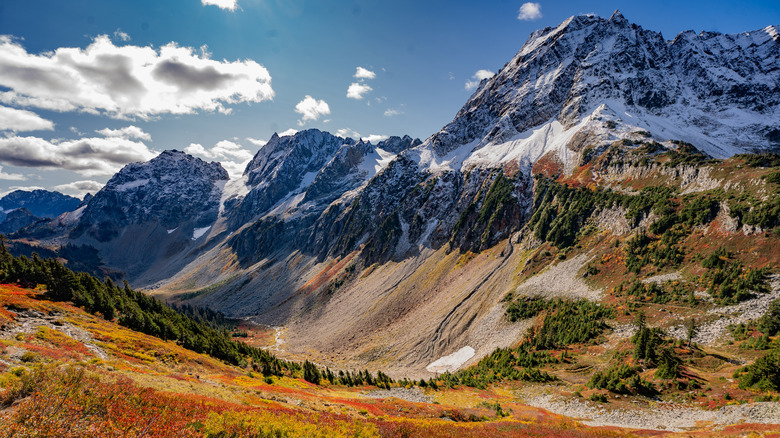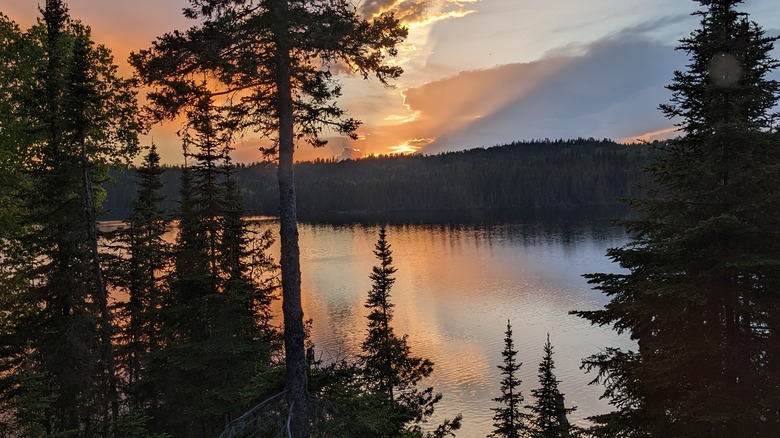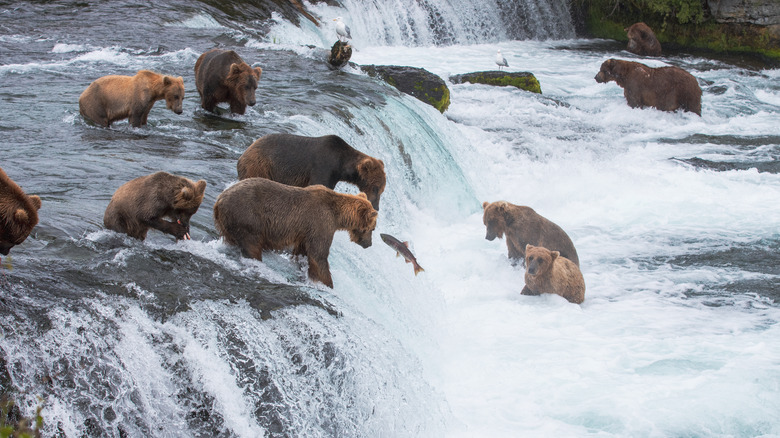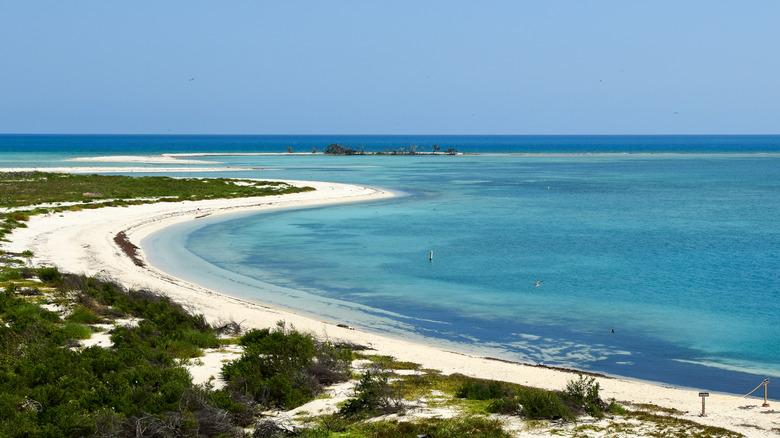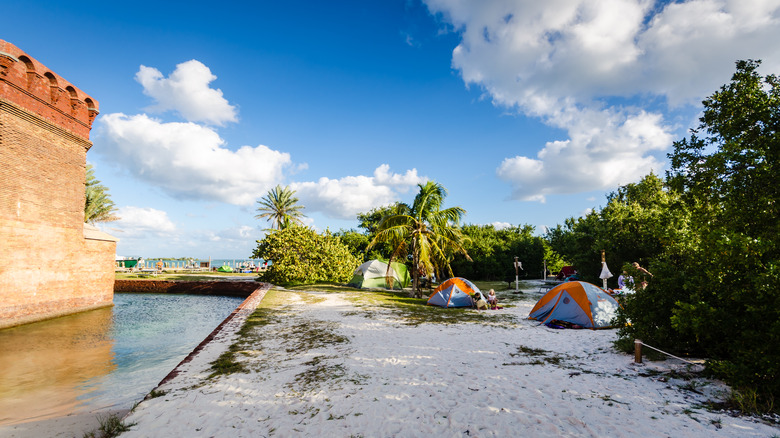These Are The Most Underrated National Parks In America (And You Won't Have To Fight Crowds To Get To Your Campsite)
When you picture the perfect national park camping trip, you might imagine peaceful evenings by the campfire, midnight strolls under the light of more stars than you've seen before in your life, and being awoken in the morning by the sound of birdsong. What you probably don't anticipate is the frustratingly common occurrence of arriving at your campground to find that you're very close to other tents and your neighbors are a large group of people hanging out and playing music all night. As fun as the party is, it's not exactly what you have in mind if you're hoping to get close to nature. If you're hoping for a more private experience, it might be time to choose a more underrated national park. As an added bonus, you probably won't have to get on a waiting list for a campsite, either.
For some gorgeous camping opportunities at some of the least-visited national parks in the United States that have established campsites for visitors to use, consider a trip to Washington state's mountainous North Cascades National Park, Michigan's lush island, Isle Royale National Park, Alaska's wild bear haven Katmai National Park, or to admire the sun, sand, sea, and stars at Florida's Dry Tortugas National Park. While we can't promise that you won't see other campers nearby, you will definitely have less competition for the best spots at these hidden gems — and a truly unique camping experience that you can't find anywhere else.
Sleep surrounded by snowy mountains in North Cascades National Park
With just 16,485 visits in 2024, North Cascades National Park is one of the absolute least visited national parks in the country, but for those who make the journey, an absolutely stunning adventure in Washington state's towering mountains, mighty glaciers, rushing waterfalls, and verdant pine forests is waiting. This gorgeous park is one of the snowiest places in the world, so if you challenge yourself to hike up into the mountains here, you can feel your boots crunch in the snow even in the hottest months of summer. This remarkable park is only a little over two hours from Seattle and there are short day hikes where you can wander through forests and near alpine lakes and mountain creeks, so theoretically, you could take a day trip to North Cascades and still experience some of its stellar views. For a longer adventure in the park, however, you're going to want to spend the night.
As wild as this place is, there are traditional campgrounds at North Cascades National Park. The easiest to access is probably the Newhalem Creek Campground, which is close enough to the visitor center that you can get to everything that you need quickly, but it still feels embedded in nature. You might also want to consider the Gorge Lake Campground, which, as its name implies, is on the lakeshore. While this park isn't particularly well known, you should still make reservations for its campgrounds and backcountry permits in advance to make sure you get the experience you're hoping for in North Cascades.
Spend the night by the lake at Isle Royale National Park
If you want to explore the largest freshwater lake on planet Earth, look no farther than Isle Royale National Park. This Michigan national park is a series of islands located in Lake Superior. To reach it, you'll have to book yourself transportation, either by boat or seaplane, across the water. Waiting on the other side is an adventure in the remote wilderness where you can escape from it all.
As isolated as these rarely visited islands are (with just 28,806 visits in 2024) there are an impressive 36 campgrounds to choose from throughout the islands. While a lot of national park campsites need to be reserved in advance, that's not the case at Isle Royale unless you're traveling with more than six people. All of the campsites here are first come first served, so you'll need to get there early and stake your claim to a spot if you want to spend the night here and get an early start on the trails. It's not necessarily an easy journey, either. You'll have to hike to campgrounds like the lakeside North Desor Campground (which is located on Lake Desor — these islands might be in Lake Superior, but they are big enough to have their own lakes, too). Other campsites like Chippewa Harbor Campground have their own dock, so if you bring a canoe or kayak you can row right up to them.
Get to know the bears by camping at Katmai National Park & Preserve
Katmai National Park & Preserve is a breathtakingly wild natural landscape in Alaska, created to protect the Valley of Ten Thousand Smokes where volcanic activity has forever altered the land. The towering mountain peaks, ancient glaciers, and rugged coastline are spectacular — but people don't just come here for the land. They come for the bears. This iconic national park is home to the Internet's favorite wildlife, a completely unprecedented number of mighty brown bears who gather together in one place to hunt for salmon. Even in Denali National Park, visitors often delight in seeing a single bear running across the landscape, but at Katmai, it's not unusual to see more than 10 bears in the same section of the river at the same time. Watching their interactions and following the stories of individual bears on the live Brook Falls webcam from Explore.org is a favorite summertime activity for people all over the world — but for an intrepid few, it's also somewhere you can visit, stay the night, and see the bears for yourself.
Although there were only 36,230 visits to Katmai in 2024, there's steep competition for space at the coveted Brooks Camp Campground. It only allows 60 people to stay there at a time. If you do manage to snag a place during bear season (June through September) you will only have to pay $18 per person for your space. There is an electric fence surrounding the area to deter curious bears. If you can't get a spot, never fear, you can always backcountry camp — if you're not worried about being out in the wilderness with the beloved bears, of course.
Sleep by the sea at Dry Tortugas National Park
There are an impressive 11 sites managed by the National Park Service in Florida. With just 84,873 total visits to the park in 2024, it's no surprise Dry Tortugas National Park is often overshadowed by popular destinations like Everglades National Park — but don't overlook this park. This unusual place is known for Fort Jefferson, a historical island fortress that was completed in 1875, but this park has more to offer. Since part of this park is ocean, 99% of the area protected. So if you love to take a boat out, swim in the blue-green waves, or snorkel and admire the world waiting beneath the surface, this is a paradise. Under the water, you'll find one of the largest coral reef systems in the world and swim alongside the incredible variety of marine life that calls the reef its home. Just make sure you know how to safely snorkel around coral reefs before you go.
You definitely can hitch a ride on a ferry to Dry Tortugas and spend a day there, but the real glory of the park emerges when you spend the night. Seeing the sun set over the waves is a beautiful experience, but don't head straight to sleep after the sun goes down. The stargazing here is incredible. Camping at Garden Key is a unique experience, but you'll have to get lucky to enjoy it. There are only eight regular campsites, and they are first come, first served and don't accept reservations except for large group sites. If you do get one, you'll only have to pay $15 for it. If you miss out, you might be able to camp out in a designated overflow area.
Methodology
To find the most underrated parks in the United States, we looked at rankings based on National Park Service visitor statistics from 2024, as reported by Smithsonian Magazine. After analyzing reviews of the least visited parks from sites like Tripadvisor, Google Reviews, and AllTrails, we felt confident that these parks were primarily not visited because they are remote and challenging to explore for the average traveler. They are all beautiful and fascinating places, beloved by those willing to make the journey, so we had no reservations dubbing any of them underrated.
Next, we eliminated those parks where there are no established campsites, like Alaska's Gates of the Arctic National Park & Preserve, which has opportunities for intrepid wilderness explorers to utilize their survival skills in nature overnight but doesn't have campgrounds. Next, we disqualified any national parks where camping is completely banned, like the National Park of American Samoa. While it does have unique opportunities to stay with locals and learn more about the traditional culture of the region, there's no way to camp outdoors. Once we had eliminated the parks without any traditional camping options, we were left with a list of rarely visited, but still extremely beautiful natural places where visitors can set up a tent and spend the night.
